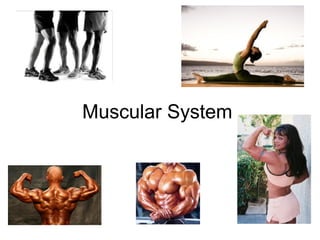
Anatomy and Physiology Muscular System
- 2. Types of Muscle • Skeletal – striated & voluntary • Smooth – involuntary • Cardiac - heart
- 4. Muscles and Muscle Fibers Muscles are composed of many fibers that are arranged in bundles called FASCICLES Individual muscles are separated by FASCIA, which also forms tendons and aponeuroses
- 8. ENERGY Fibers contain multiple mitochondria for energy Most fibers have multiple nuclei
- 10. SARCOLEMMA Sarcolemma = muscle fiber membrane Sarcoplasm = inner material surrounding fibers (like cytoplasm) Myofibrils = individual muscle fibers --> made of myofilaments
- 11. Myofibril Contains protein filaments – ACTIN (thin) and MYOSIN (thick) These filaments overlap to form dark and light bands on the muscle fiber A band = dArk • thick (myosin) I band = lIght • thIn (actin) • In the middle of each I band are Z lines. A sarcomere is on Z line to the other
- 15. It is important to remember the heirarchy myosin myofibrils fasicles myofilaments actin
- 16. It is important to remember the heirarchy fasicles myofibrils myofilaments actin myosin
- 17. muscle fiber myofilament myofibrils epimysium muscle sarcomere
- 18. myofilament muscle sarcomere epimysium myofibrils muscle fiber
- 21. Muscles & Nervous System
- 22. Motor Unit The muscle fiber and the motor neuron
- 24. SLIDING FILAMENT THEORY (MODEL) The theory of how muscle contracts is the sliding filament theory. The contraction of a muscle occurs as the thin filament slide past the thick filaments. The sliding filament theory involves five different molecules plus calcium ions. The five molecules are: myosin actin tropomyosin troponin ATP
- 27. ANIMATION OF SLIDING FILAMENT http://www.blackwellpublishing.com/matthews/myosin.html
- 28. Energy Source • Provided by ATP from cellular respiration (mitochondria) • Creatine phosphate increases regeneration of ATP • Much of the energy forms heat, which keeps our bodies warm
- 30. Other Terms • 1. Threshold Stimulus • 2. All-or-None Response • 3. Motor Unit • 5. Recruitment • 6. Muscle Tone • 7. Muscular Hypertrophy • 8. Muscular Atrophy • 9. Muscle Fatigue • 10. Muscle Cramp • 11. Oxygen Debt
- 31. Threshold Stimulus Minimal strength required to cause a contraction Motor neuron releases enough acetylcholine to reach threshold All-or-None Response Fibers do not contract partially, they either do or don't
- 32. Motor Unit The muscle fiber + the motor neuron Recruitment more and more fibers contract as the intensity of the stimulus increases Muscle Tone Sustained contraction of individual fibers, even when muscle is at rest
- 34. Hypertrophy - muscles enlarge (working out or certain disorders) Atrophy - muscles become small and weak due to disuse
- 35. Muscle Fatigue - muscle loses ability to contract after prolonged exercise or strain Muscle Cramp - a sustained involuntary contraction Oxygen Debt - oxygen is used to create ATP, during exercise you may not have enough oxygen --> this causes Lactic Acid to accumulate in the muscles *See Magic School Bus
- 36. Origin and Insertion Origin = the immovable end of the muscle Insertion = the movable end of the muscle **when a muscle contracts the insertion is moved toward the origin The biceps brachii has two origins (or two heads).
- 37. What is rigor mortis? A few hours after a person or animal dies, the joints of the body stiffen and become locked in place. This stiffening is called rigor mortis. Depending on temperature and other conditions, rigor mortis lasts approximately 72 hours. The phenomenon is caused by the skeletal muscles partially contracting. The muscles are unable to relax, so the joints become fixed in place.
- 38. What is tetanus? Tetanus causes cholinosterase to not break down the acetylcholine in the synapse. This results in a person's muscles contracting and not relaxing. A tetanus shot must be administered shortly after exposure to the bacteria. Once you develop tetanus, there is no cure.